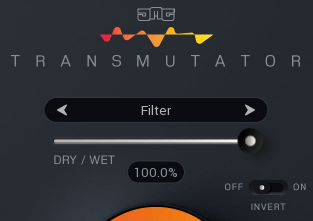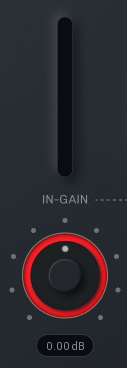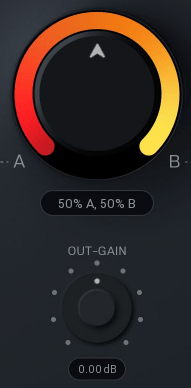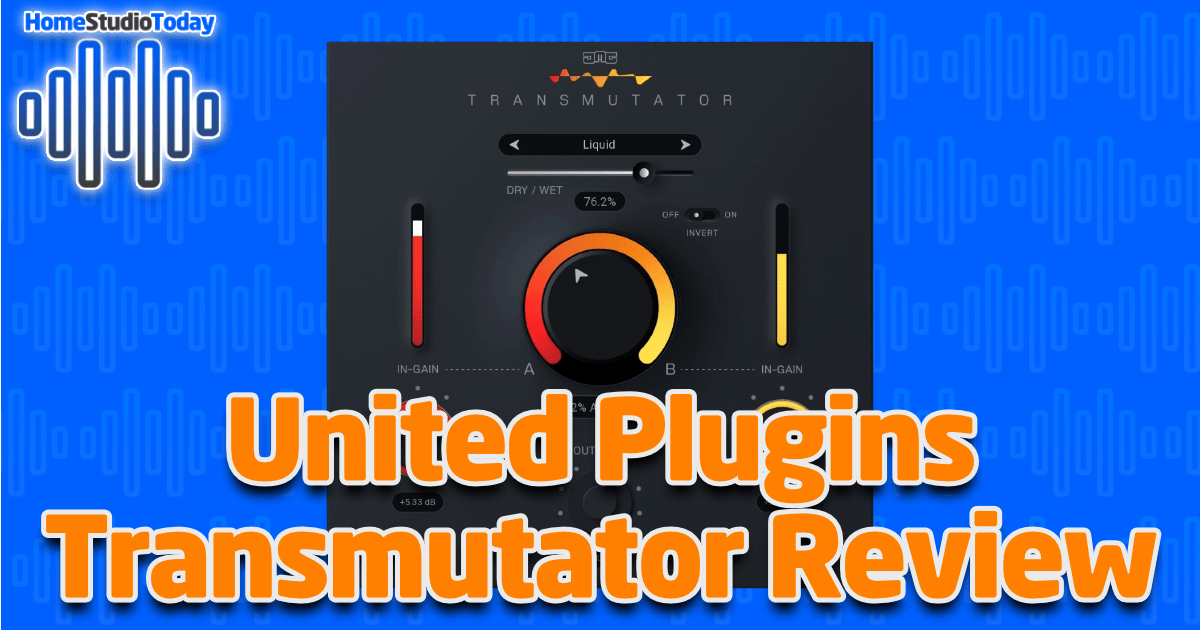If you enjoy this review and decide to grab the deal, please consider clicking through one of my links before you buy. I earn a small commission at no cost to you, which helps support this site and keep the reviews coming. Thanks!
I’ve had the pleasure of reviewing several United Plugins in the past, most of which were designed to emulate vintage hardware. Today I’m looking at United Plugins’ Transmutator, which is anything but. Described as a “cutting-edge tool that crossfades between two inputs in a multitude of exciting ways,” I’m extremely curious to find out how Transmutator works and how I can use it in my home studio. Let’s check it out.
Looks

Transmutator opens to a dark grey interface with a contoured look around the controls. On the left is the A input source section, and on the right is the B, with a crossfade and output gain dial in the middle. Each input section has an input gain control with meter. The A source section has red controls and meter, B has yellow, and the dial in the middle has a gradient with orange in the middle. Below the Transmutator logo is a Mode selector, dry/wet blend, and mode Invert toggle. A clean, straighforward interface with large, easy-to-understand controls.

Features
Transmutator has simple controls with a lot of functionality. Let’s take a detailed look at each of its features:
Modes, Dry/Wet Blend, and Invert

Transmutator comes with sixteen different modes for crossfading your sources. Each one of the modes employs a different variation on a common theme – source A, which is the main track audio, is blended into source B on the sidechain. The modes are Filter (high-pass/low-pass), Spectrum (tonal and noise), Morph (spectral algorithmic), Stereo (mid/side), Pan (left/right), Transients (transient and tail), Dynamics (quiet/loud), Follow (amplitude shaping), Liquid (spectral multiband), Multi (frequency multiband), Diffuse (spectral randomizer), Wash (reverb), Blur (spectral freezing and blurring), Pitch (2-octave pitch modulation), Shift (1kHz pitch shifting), and Degrade (distortion).
The Dry/Wet blend allows you to fine-tune the amount of effect applied, so 0% (dry) does a simple volume-only crossfade, and 100% (wet) uses only the effect of the currently-selected mode. The Invert function has various uses depending on which mode is selected, and could be as simple as just flipping the two sources, or as complex as switching whether the odd or even bands are blended in the multiband modes.
Source Meter and Input Gain

Each source has an Input Gain control and an independent input meter. The red or yellow meter bar turns white at the top if the source is near clipping.
Crossfader and Output Gain

The crossfader is a large, colorful A/B knob that blends between the two sources. Depending on the mode selected, the blend setting, and the input sources applied, the effect can be subtle or radical. The Output gain controls the total sound output of the plugin overall.

Usability
Before I started playing with Transmutator, my first question was “what does this do that a basic volume automation can’t?” Based on the description alone, I thought that Transmutator only did simple crossfading – which it does – but it also does a lot more. A far better question, then, is “what can I do with Transmutator with automation,” and the answer was, “a lot.”
Once I got the sidechain set up, I started playing with the crossfader and found that it had a nifty effect when applied to both sides of a stereo track in Filter mode. I ran an LFO in Reaper to make the two tracks crossfade repeatedly to the tempo of the track, making a very cool whooshing effect as the two sides of the stereo pair flipped back and forth.
Some of my other favorite modes were Transients, Liquid, and Degrade. I really liked the way that Transients crossfades using just the loudest transients at first, making it sound like the other source is “coming for you” in a way, like a freight train coming down the tracks from far away. The Dry/Wet control made it easy to add a hint of a fun effect without making it overpowering.
The uses for Transmutator in a mixing session are numerous, both when at a fixed setting or with automations. I could definitely see it as a useful plugin in a live setup as well. There is a 64-bit VST2 version and an AU version, so it can be used as a third-party plugin in Serato. I would love to see a live EDM set using Transmutator to create some very cool transition effects.

Hear it in Action
Below are two samples of Transmutator. The first one employs the Filter mode with LFO I mentioned above. The Filter is set to about 80% blend, and the LFO is set to 2x tempo at about 25% intensity. This really shows off the smoothness with which Transmutator crossfades using its algorithms. The second sample is a simple crossfade using the same sample, this time in Transients mode. You can hear as it fades from right to left that the left channel starts picking up the transients of the sample first, then slowly fills in the tails and fades out the right channel altogether towards the end.
United Plugins Transmutator Review – The Bottom Line
There are several other options on the market for crossfader plugins, but none that I could find that have anywhere near the effects options built into Transmutator. In that regard it has a completely unique featureset. Setting up many of the complicated crossfades with blended effects that this plugin does in seconds would take hours using nothing but automations. As such, I would say the price United Plugins is asking for Transmutator is totally fair.

I didn’t expect to be all that impressed with Transmutator. After all, what can be special about a crossfader? As it turns out, the complement of distinctive effects, used live or in tandem with automation, create a quirky and fun plugin. I can definitely see myself using Transmutator in mix sessions where I’m looking for a unique transition or a nifty “what the heck was that” effect on a stereo buss. In the end, I didn’t find a single fault in Transmutator, and give it a full 5 stars and my recommendation.

Unique crossfader plugin with 16 different modes to vary the crossfade effect.

